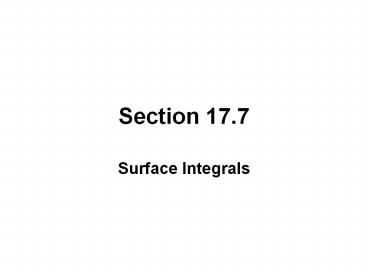Surface%20Integrals - PowerPoint PPT Presentation
Title:
Surface%20Integrals
Description:
Section 17.7 Surface Integrals THE SURFACE INTEGRAL SUMMARY EXAMPLES MASS AND CENTER OF MASS EXAMPLE ORIENTED SURFACES CLOSED SURFACES AND ORIENTATION A closed ... – PowerPoint PPT presentation
Number of Views:136
Avg rating:3.0/5.0
Title: Surface%20Integrals
1
Section 17.7
- Surface Integrals
2
THE SURFACE INTEGRAL
Suppose f is a function of three variables
whose domain includes the surface S. We divide S
into patches Sij with area ?Sij. We evaluate f
at a point in each patch, multiply it by
the area ?Sij, and form the sum Then we take the
limit as the patch size approaches 0 and define
the surface integral of f over the surface S as
3
Suppose the surface S is a graph of a function of
two variables g(x, y), where (x, y) are in some
region D. Divide D into smaller rectangles Rij
of equal size. The patch Sij lies directly above
the rectangle Rij and the point in Sij is of
the form . We use the
approximation If f is continuous on S and g
has continuous derivatives, then the definition
on the previous slide becomes.
4
SUMMARY
If z g(x, y), then
NOTE Similar formulas apply when it is more
convenient to project S onto the yz-plane or
xz-plane.
5
EXAMPLES
1. Evaluate the surface integral where S is the
first octant portion of the plane 2x y 2z
6. 2. Evaluate the surface integral where S is
the first octant portion of the cylinder y2 z2
9 between x 0 and x 4.
6
MASS AND CENTER OF MASS
Suppose a thin sheet has the shape of the surface
S and that that ?(x, y, z) is the density
function for the sheet. Then the mass of the
sheet is Its center of mass is
7
EXAMPLE
A cone-shaped surface lamina S is given by At
each point on S, the density is proportional to
the distance between the point and the z-axis.
Find the mass m of the lamina.
8
ORIENTED SURFACES
We only want to consider two-sided, orientable
surfaces, We start with a surface that has
tangent planes at every point (x, y, z) on S.
There are two unit normal vectors n1 and n2
-n1. If it is possible to choose a unit normal
vector n at every point (x, y, z) so that n
varies continuously over S, then S is called an
oriented surface and the given choice of n
provides S with an orientation. Thus, there are
two possible orientations for any orientable
surface which correspond to the choice for normal
vectors.
9
For a surface z g(x, y) given as the graph of
g, we see that the induced orientation is given
by the unit normal vector Since the
k-component is positive, this gives the upward
orientation of the surface.
10
CLOSED SURFACES AND ORIENTATION
- A closed surface is a surface the is the boundary
of a (closed) solid region E. - The positive orientation of a closed surface is
the one for which the normal vectors point
outward from the region E.
11
FLUX INTEGRAL
Suppose that S is an oriented surface with unit
normal vector n, and imagine a fluid with density
?(x, y, z) and velocity field v(x, y, z) flowing
through S. Then the rate of flow (mass per unit
time) per unit area is ?v. If we divide S into
small patches Sij, then Sij is nearly planar and
so we can approximate the mass of fluid crossing
Sij in the direction of the normal n per unit
time by the quantity (?v n)A(Sij) where ?, v,
and n are evaluated at some point on Sij. By
summing these quantities and taking the limit we
get the surface integral of the function ?v n
over S and this is interpreted physically as
the rate of flow through S.
12
FLUX INTEGRAL (CONTINUED)
If we write F ?v, then F is also a vector
field on and the integral on the previous slide
becomes A surface integral of this form occurs
frequently in physics, even when F is not ?v, and
is called the surface integral (or flux integral)
of F over S.
13
SURFACE INTEGRAL OF A VECTOR FIELD
If F is a continuous vector field defined on an
oriented surface S with unit normal vector n,
then the surface integral of F over S is This
integral is also called the flux of F across S.
In words, this definition says that the surface
integral of a vector field over S is equal to the
surface integral of its normal component over S.
14
EXAMPLE
Let S be the portion of paraboloid z g (x, y)
4 - x2 - y2 lying above the xy-plane. Find the
upward flux of F(x, y, z) xi yj zk across
the surface S.
15
In the case of a surface S given by a graph z
g(x, y), we can find n by noting that S is also
the level surface f (x, y, z) z - g(x, y) 0.
We know that the gradient is
normal to this surface at (x, y, z) and so a unit
normal vector is Using the formula for the
surface integral from Slide 4 to evaluate the
flux integral with F(x, y, z) P(x, y, z)i
Q(x, y, z)j R(x, y, z)k we get the following
16
(No Transcript)
17
EXAMPLE
Evaluate the flux for the vector field F(x, y, z)
xi yj zk across S which is the first
octant portion of the sphere x2 y2 z2 16,
taking n to be the upward normal.































